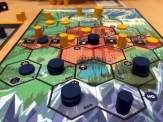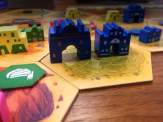| Release Date: 2021 | Players: 2-4 |
| Designer: Janko Nišavić, Vukašin Nišavić | Length: 120-240 minutes |
| Artist: Nenad Mirković | Age: 12+ |
| Publisher: Princeps Games | Complexity: 2.5 / 5 |
March on the Drina by Princep Games is a war game set during World War I, or more specifically the Serbian campaign, where one player controls the Serbian forces, which are technically supported by Montenegro, but that country has no forces or financial power of its own, while 1 to 3 other players control the opposing side of Germany, Austria-Hungary and Bulgaria.
The Setting
The Serbian campaign during World War I began after Austria-Hungary declared war on Serbia on 28 July 1914 and was also known as the campaign to “punish” Serbia. In the first campaign, Serbia successfully defended itself three times again Austria-Hungary, when, in the second campaign, Germany, Austria-Hungary and Bulgaria joined forces and attacked Serbia from three sides. Serbian forces had no choice but to retreat through Montenegro and Albania and evacuate to Greece1.
Eventually, in September 1918, France joined the battle and a Franco-Serbian force liberated Serbia, Albania and Montenegro. Serbian forces continued their march and reached Belgrade on 1 November 1918, effectively ending this part of World War I1.
Casualties during the campaign were very high. The Serbian Army lost around 75% of its force and it is claimed that over 1 million Serbian inhabitants lost their lives during the war or around 29% of its population, but these figures may have been lower. In contrast, France lost around 16% of its military force and Germany around 15%1.
It is clear that World War I as a whole was a bloody war and the effects of this global conflict were felt for decades afterwards and even though the war in Serbia depicted in March on the Drina was only a part of it, it was no less terrible.
The Game
March on the Drina is a war game, where players represent either Serbia, Austria-Hungary, Germany or Bulgaria. Actually, the game can be played from two to four players, so who controls which nation will depend on player count, but one player will always just play Serbia. In a two-player game, the other player will control the other three nations, while in a three-player game, one player controls Austria-Hungary and the other Germany and Bulgaria. In a four-player game, each player controls one nation only, of course.
The game map shows all of Serbia and then along the outside, going clockwise from the northeast, has a small section of Austria-Hungary, Romania, Bulgaria, Greece, Albania and Montenegro. Like in so many other war games, everything is divided into hexagons, some of which cannot be entered and represent mountains or bodies of water.
The game is played over a certain number of rounds, unless one side can occupy a certain number of cities for a whole round, until it is their turn again. That is quite hard to achieve, so most games will go for the whole length and the winner is decided by who controls most cities in Serbia and Montenegro at the end of the last round.
Each round represents a certain time period during the war in Serbia and is depicted on a small, ringbound desk calendar. Every page on the calendar has a photo and quite a few paragraphs describing the events of the time, as well as a short call-out box that tells players any special effects, such as one country losing a unit or getting a bonus when attacking. Players are allowed to look ahead, so they can plan for what’s coming to benefit from the effect of the upcoming time periods.
Every player starts with a certain number of forces of different types, infantry, cavalry and artillery, which are secretly placed on the map at the start. That is achieved via a notepad showing a small version of the full map onto which players secretly note the positions of their starting troops. Once everyone has made their choice, the maps are revealed and the relevant units are placed onto the game board.
That means every game can start slightly differently and opposing forces don’t necessarily face each other directly from the beginning. Mind you, given that players are trying to occupy a certain number of Serbian cities for a whole round to win the game, there will be certain locations that are likely to be occupied straight away or at least there will be certain positions near those cities that troops will be placed to protect them against enemy occupation.
There are also generals in the game, each of whom has a special ability and troops within a certain number of steps of the general will benefit from that ability and only those troops will be able to be reinforced during the rounds when this is possible. Reinforcements don’t happen every round though, so troops tend to act quite independently of their general for quite a lot of the time in the game, but as a reinforcement round approaches, players will try and move their troops and generals closer together, so they can refresh their army’s strength.
However, new troops aren’t free. Every nation has a certain amount of so-called military capacity, which is basically a figure equivalent to money, that players collect at the end of their turn and that goes up or down as you occupy or lose cities in battle. Cities in your own country are more valuable to you, while enemy cities still increase your military capacity, but by a lot less. That represents the fact that producing ammunition, weapons and other equipment and drafting new soldiers is easier in your home country and while it is possible in an occupied enemy city, it’s not quite as successful or productive.
On your turn, you can use each unit you have once. You don’t have to employ every unit and you decide, one-by-one, which unit to activate. Depending on the unit, you can move a certain number of hexes and if you land on an enemy unit, battle commences. Rather than rolling dice, in March on the Drina, both sides draw a card from a deck that has a mix of different modifier cards, ranging from zero to plus three. You add that number to your unit’s attack or defence value and the unit’s strength, i.e. the number of tokens the unit comprises of, and whoever has the higher number, wins the battle. The loser has to remove one token from their unit, or remove the unit completely if there is only one token left, and then retreat away from the attacker by one hex, if there is anything left of the unit after the fight.
It’s really pretty simple and quick and the rulebook suggests you modify the deck depending on whether you want more or less randomness in the game. That’s a really wonderful touch making battles relatively predictable, without making them certain. Additionally, some units are better in attack, others better in defence, so you have to choose what units you use for what, making it important you have the right ones in place.
Also, the defender isn’t far away and can launch a counter-attack on their turn, be it at a slightly reduced strength. So it is possible that battles for a city go backwards and forwards, with the nation controlling the city changing with every battle, until eventually one side has been completely wiped out.
However, the map is quite large, compared to the number of troops, so battles aren’t necessary to take over control of a city. It is very likely that one or two of your units will outflank the opponent and make a run for it down one side, hoovering up cities as they go. The defender will be hard pushed to catch up, let alone prevent this from happening. Serbia certainly has its work cut out to try and control the battle taking place on three fronts.
The way March on the Drina is implemented allows players to formulate an overall strategy, which they will have to adapt as the situation on the board changes. Tactics are required, but there is some real forward planning needed too to ensure that there are enough troops available to fill the ranks and push through the enemy line. You also need to keep an eye on the calendar to make sure you don’t miss a vital reinforcement phase.
March on the Drina does seem to reflect the events from history pretty well, at least in broad strokes, as Serbia is quite strong at the beginning, then really loses ground halfway through and then comes back stronger near the end. Serbia’s opponents really have to work together to have a chance of winning the game. As I said, most of the time it will be decided on the last turn, so trying to push for an early victory is definitely an option and something that you should bear in mind, but don’t run out of energy too soon or you will stand no chance of lasting the game. You have to keep your eye on both winning conditions at all times.
Here is a really good war game that makes players work hard for their victory and forces them to think ahead and plan well, while also being able to respond to unexpected turns of events.
The Verdict
March on the Drina works very hard to try and remind players of the real-world events that took place during World War I as they relate to the war in Serbia. The map reminds me of those you would see in news pieces from the time, showing how troops were attacking or defending. All the relevant places are marked and every relevant city is named.
The rulebook’s first page is dedicated to the history around the World War I conflict in Serbia and the events leading up to it. It definitely sets the scene for the game and is an important read to better understand what it is as a player that you are doing and how it relates to the historic events of the time.
As players, you will also choose generals from those that are authentic to the time period. The generals’ abilities try to represent the real person’s strategies and approaches during the war and each one is briefly described on its accompanying card, giving you another hint at the motivation of the war and the characters involved.
The long descriptions on the calendar really bring to life what happened during that time and the round effects reflect that and force players to build them into their strategy. Suddenly losing a unit in one round can be decisive and players do get a very small sense of how brutal the war was in that respect.
Deciding which units to reinforce is also another moment when players have to think hard about where to invest their military capacity and suddenly realising that some troops are too far away from a general to have any hope of help does make you wonder what it might have been like in the real war.
However, March on the Drina, like so many war games, is unable to really bring home the loss of life, the suffering and the full brutality of the war in Serbia. Winning a battle is a matter of removing a token and moving units around the board. There is no sense of how many people would have died, how many would have been wounded and how many civilians might have been caught up in the conflict and what they may have endured as a result.
The rulebook is not bad, but will take a couple of reads to properly understand. It was translated from Serbian into English, so it is understandable that some things are not quite clear. Also, the rulebook doesn’t use “they” to address the reader or the players, but “he/she” instead. Again, this is likely a result of the translation from a language where every noun has a gender and verbs will change depending on the speaker’s gender2 as well and where “they” isn’t an established first person singular pronoun.
So, if you want to learn more about the history of the World War I conflict in Serbia, then March on the Drina does a very good job of narrating the story and making it a little easier to understand as you play the game.
Sources
- Wikipedia: Serbian campaign: https://en.
wikipedia. org/ wiki/ Serbian_ campaign - Wikibooks: Serbian grammar – gender: https://en.
wikibooks. org/ wiki/ Serbian/ Grammar
For behind-the-scenes updates, branded merchandise, and more, please support the blog.
Useful Links
- March on the Drina: https://princepsgames.
com/ march-on-the-drina/ - Princeps Games: https://princepsgames.
com/ - BGG listing: https://boardgamegeek.
com/ boardgame/ 298728/ march-drina
Transparency Facts
I feel that this review reflects my own, independent and honest opinion, but the facts below allow you to decide whether you think that I was influenced in any way. Please also read my Ethics Statement for more information.- I bought and paid for the game myself.
- At the time of writing, I have not received financial support from the publisher or anyone working on their behalf.
Audio Version
Intro Music: Bomber (Sting) by Riot (https://www.






